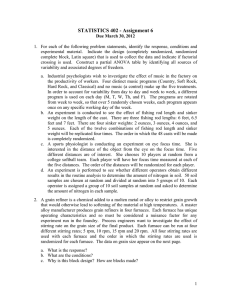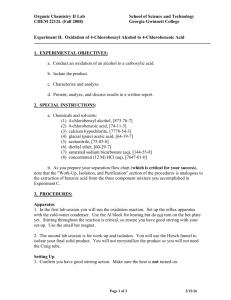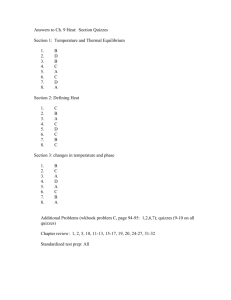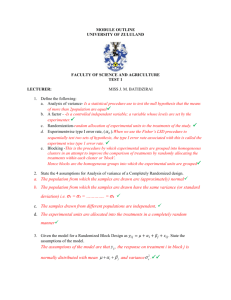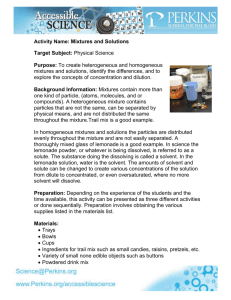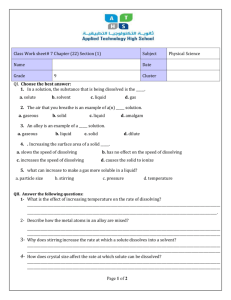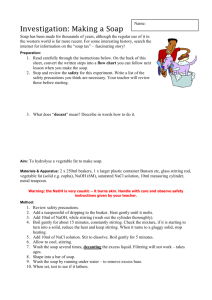STAT 496, Spring 2005 Homework Assignment #6
advertisement
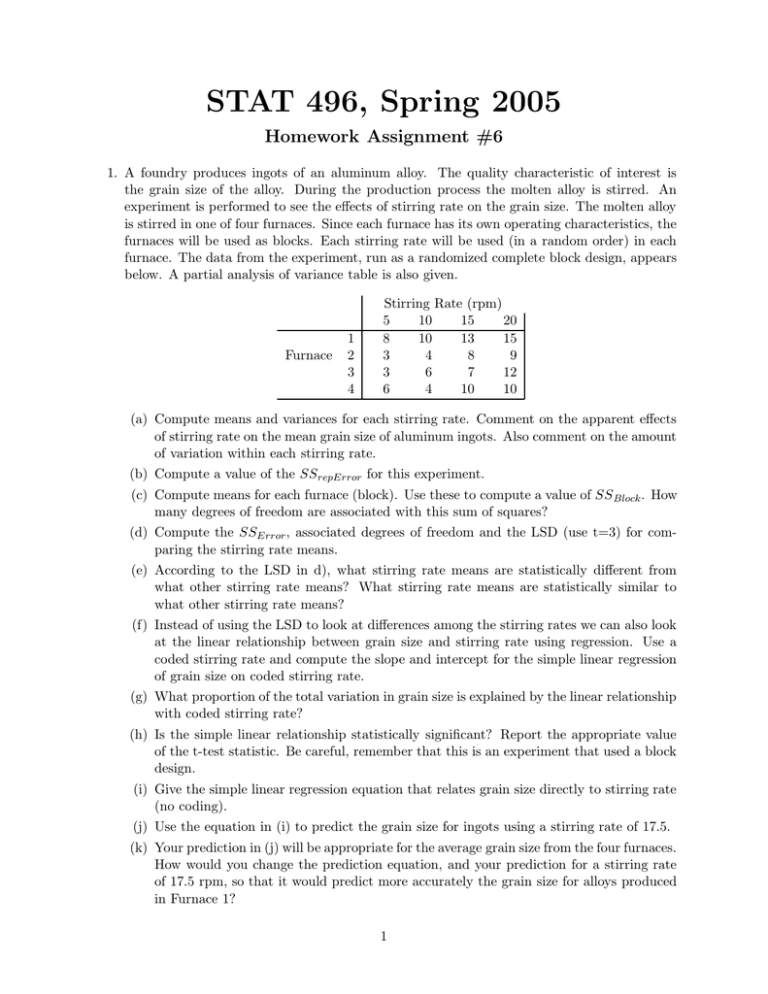
STAT 496, Spring 2005 Homework Assignment #6 1. A foundry produces ingots of an aluminum alloy. The quality characteristic of interest is the grain size of the alloy. During the production process the molten alloy is stirred. An experiment is performed to see the effects of stirring rate on the grain size. The molten alloy is stirred in one of four furnaces. Since each furnace has its own operating characteristics, the furnaces will be used as blocks. Each stirring rate will be used (in a random order) in each furnace. The data from the experiment, run as a randomized complete block design, appears below. A partial analysis of variance table is also given. Furnace 1 2 3 4 Stirring Rate (rpm) 5 10 15 20 8 10 13 15 3 4 8 9 3 6 7 12 6 4 10 10 (a) Compute means and variances for each stirring rate. Comment on the apparent effects of stirring rate on the mean grain size of aluminum ingots. Also comment on the amount of variation within each stirring rate. (b) Compute a value of the SSrepError for this experiment. (c) Compute means for each furnace (block). Use these to compute a value of SS Block . How many degrees of freedom are associated with this sum of squares? (d) Compute the SSError , associated degrees of freedom and the LSD (use t=3) for comparing the stirring rate means. (e) According to the LSD in d), what stirring rate means are statistically different from what other stirring rate means? What stirring rate means are statistically similar to what other stirring rate means? (f) Instead of using the LSD to look at differences among the stirring rates we can also look at the linear relationship between grain size and stirring rate using regression. Use a coded stirring rate and compute the slope and intercept for the simple linear regression of grain size on coded stirring rate. (g) What proportion of the total variation in grain size is explained by the linear relationship with coded stirring rate? (h) Is the simple linear relationship statistically significant? Report the appropriate value of the t-test statistic. Be careful, remember that this is an experiment that used a block design. (i) Give the simple linear regression equation that relates grain size directly to stirring rate (no coding). (j) Use the equation in (i) to predict the grain size for ingots using a stirring rate of 17.5. (k) Your prediction in (j) will be appropriate for the average grain size from the four furnaces. How would you change the prediction equation, and your prediction for a stirring rate of 17.5 rpm, so that it would predict more accurately the grain size for alloys produced in Furnace 1? 1 2. An experiment is performed on a new piece of drilling equipment. The response variable is the rate of advance of the drill. The four factors (each with a low (–1) and high (+1) level) are A: Load on the drill, B: Flow Rate through the drill, C: Speed of Rotation, D: Amount of Mud used in drilling. The experiment is run as a single replicate full factorial with five center points. The data are given below. Refer to the JMP output for drilling experiment. Trmt. Comb. 1 a b ab c ac bc abc d ad bd abd cd acd bcd abcd A −1 +1 −1 +1 −1 +1 −1 +1 −1 +1 −1 +1 −1 +1 −1 +1 0 0 0 0 0 B −1 −1 +1 +1 −1 −1 +1 +1 −1 −1 +1 +1 −1 −1 +1 +1 0 0 0 0 0 C −1 −1 −1 −1 +1 +1 +1 +1 −1 −1 −1 −1 +1 +1 +1 +1 0 0 0 0 0 D −1 −1 −1 −1 −1 −1 −1 −1 +1 +1 +1 +1 +1 +1 +1 +1 0 0 0 0 0 Rate 1.68 1.98 3.28 3.44 4.98 5.70 9.93 9.07 2.07 2.44 4.09 4.53 7.77 8.43 11.75 12.30 4.54 5.18 5.53 4.49 5.01 (a) Give the overall sample mean and the estimated full effects for the factorial portion of the experiment. (b) Give the mean at the center points and the sample variance at the center points. (c) Use the sample variance at the center points to determine the critical effect size for a factor or interaction term. Use t=3. (d) Use the critical effect size in c) to determine which factors and/or interactions are statistically significant. (e) Is there significant curvature? Support your answer by performing the appropriate test of hypothesis. (f) According to JMP, which factors and/or interactions are statistically significant? Use t=3. (g) Why are the results in d) different from the results in f)? 2

